
Mighty fortress. Royal palace. Infamous prison.
The Tower of London's history spans almost a thousand years, but London's castle can still fascinate and horrify. When William the Conqueror built this mighty stone tower at the centre of his London fortress, defeated medieval Londoners must have looked on in awe.
As protector of the Crown Jewels, home of the Yeomen Warders and its legendary guardians, the pampered ravens, the Tower now attracts over three million visitors a year. Here, the Ceremony of the Keys and other traditions live on, as do the ghost stories and terrible tales of torture and execution.
Throughout history, the Tower has also been a visible symbol of awe and fear. Kings and queens imprisoned their rivals and enemies within its walls. The stories of prisoners, rich and poor, still haunt the Tower.
But the Tower also has a richer and more complex history, having been home to a wide array of institutions including the Royal Mint, the Royal Armouries and even a zoo.
As the most secure castle in the land, the Tower guarded royal possessions and even the royal family in times of war and rebellion. But for 500 years monarchs also used the Tower as a surprisingly luxurious palace.
Listen to the Tower of London story
Listen to the contents of this page read by our team here, or keep scrolling to read about the history of the Tower of London with images.
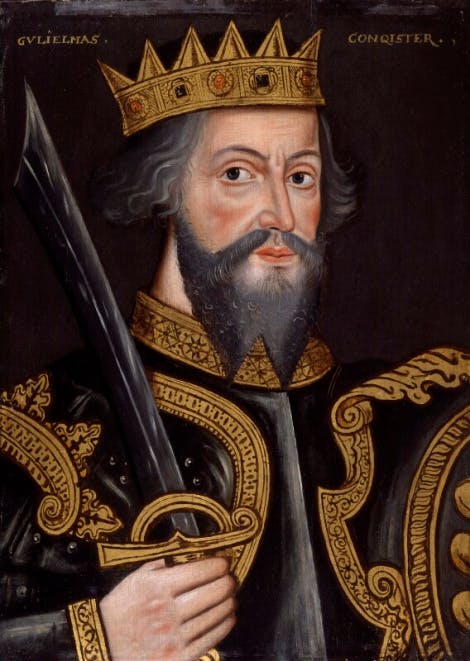
Image: King William I ('The Conqueror') by an unknown artist, © National Portrait Gallery, London.
When was the Tower of London built?
The Tower of London was built in the 1070s by William the Conqueror. Fresh from his victory and coronation but nervous of rebellion, William began to build this massive stone fortress to defend and proclaim his royal power. It took around 20 years to build.
Masons arrived from Normandy, bringing with them stone from Caen in France. Most of the actual labour was provided by Englishmen.
Nothing like it had ever been seen in England before. William intended his mighty castle keep not only to dominate the skyline, but also the hearts and minds of the defeated Londoners.
Read more: The Medieval Palace
The fortress expands
Throughout history, the Tower has been adapted and developed to defend and control the nation.
Henry III (1216-72) and his son Edward I (1272-1307) expanded William’s fortress, adding huge 'curtain' (defensive) walls with a series of smaller towers, and enlarging the moat.They also transformed the Tower into England’s largest and strongest 'concentric' castle (with one ring of defences inside another).
In 1240, Henry III had the Tower’s great keep painted white, making it the White Tower.
Inside the Tower, the kings built a magnificent medieval palace. They stayed here with their queens, Eleanor of Provence (Henry's queen) and Eleanor of Castile (Edward's queen).

Image: Illustration of how the Tower may have looked, c1300 by Ivan Lapper. © Historic Royal Palaces
Tower of strength
Kings and queens used the Tower in times of trouble to protect their possessions and themselves. Arms and armour were made, tested and stored here until the 1800s.
The Tower also controlled the supply of the nation’s money. All coins of the realm were made at the Tower Mint from the reign of Edward I until 1810. Kings and queens also locked away their valuables and jewels at the Tower and even today, the Crown Jewels are protected by a garrison of soldiers.
The Tower’s defences failed only failed once. During the Peasants’ Revolt of 1381, rebels ran in through the open gates!
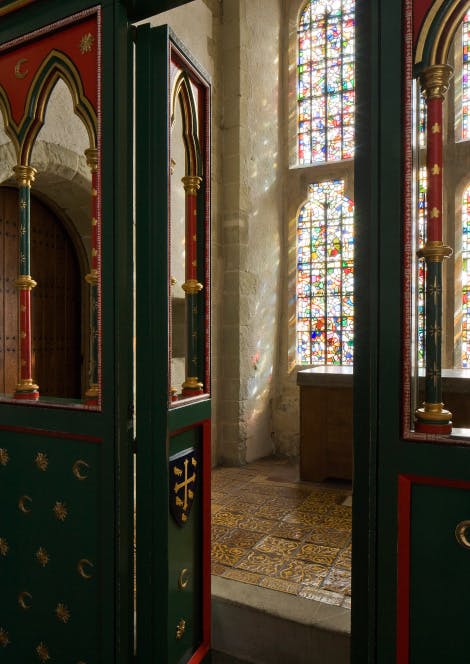
Image: Henry VI was supposedly murdered while at prayer in the King's Private Chapel in the Wakefield Tower.
Henry VI and the Wakefield Tower
The Tower of London has also been the infamous setting for stories of royal tragedy and death.
During the Wars of the Roses, Henry VI was murdered here in 1471 and, later, the children of his great rival Edward IV – the Princes in the Tower - vanished within its walls in 1483.
In 1674, two skeletons were unearthed at the Tower. The bones were re-examined in 1933 and proved to be those of two boys aged about 12 and 10, exactly the same ages as the princes when they disappeared.
Read more: Henry VI: England's Youngest Monarch
Yeoman Warders at the Tower of London
The famous Yeoman Warders, recognised as symbols of the Tower all over the world, have been here for centuries. They were originally part of the Yeomen of the Guard, the monarch’s personal bodyguard who travelled with him.
Henry VIII (1507-47) decreed that some of them would stay and guard the Tower permanently.
Did you know?
Henry VII's personal guards were the first 'Beefeaters', so named as they were permitted to eat as much beef as they wanted from the King's table.
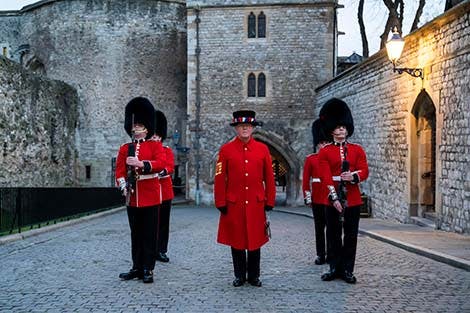
Image: Chief Yeoman Warder Peter McGowran poses with Coldstream Guards infantry soldiers © Historic Royal Palaces.
Ceremony of the Keys
Today the Yeomen Warders or the 'Beefeaters' guard the visitors, but still carry out ceremonial duties, such as unlocking and locking the Tower every day in the Ceremony of the Keys.
They wear their red state ‘dress uniforms’ for important occasions at the Tower, and also for special events such as the firing of the huge cannon on the Wharf, known as the Gun Salutes.

Experience the Ceremony of the Keys
Be part of this 700-year-old ancient ceremony at the Tower of London.
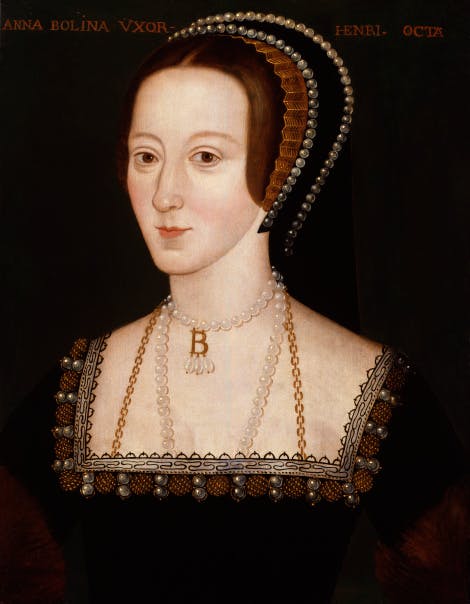
Image: Portrait of Anne Boleyn. © National Portrait Gallery, London.
Royal life and death
Medieval kings and queens lived in luxurious apartments at the Tower. They worshipped in the Chapel Royal, kept a menagerie of exotic animals (which lasted until the 19th century) and welcomed foreign rulers at magnificent ceremonial occasions.
Although long since vanished, there was once a splendid royal palace to the south of the White Tower. Henry VIII modernised the rooms inside in preparation for the coronation of his new bride, Anne Boleyn in 1533. She and the King feasted here in splendour the night before Anne processed in triumph through the City of London to Westminster Abbey.
Three years later Anne was back at the Tower, this time accused of adultery and treason. She was held in the same luxurious lodgings before being executed by sword on Tower Green.
But not all queens died here at the hands of an executioner. Elizabeth of York died after giving birth at the Tower. It was said that her husband Henry VII was so grief-stricken at her death that his hair turned white.

Image: The Last Moments of Lady Jane Grey, Hendrik Jacobus Scholten (1824-1907). © Historic Royal Palaces.
'Sent to the Tower'
The Tower of London as a prison
For over 800 years, men and women have arrived at the Tower, uncertain of their fate. Some stayed for only a few days, other many years.
During the Tudor period, the Tower of London became the most important state prison in the country. Anyone thought to be a threat to national security came here.
The future Elizabeth I, Lady Jane Grey, Sir Walter Raleigh and Guy Fawkes were all 'sent to the Tower'.
Even during the First World War, German spies were brought here and shot.
Read more: The Tower of London as a prison
The Chapel Royal of St Peter ad Vincula
The Chapel of St Peter ad Vincula is perhaps best known as being the burial place of some of the most famous Tower prisoners. These include three queens of England: Anne Boleyn, Catherine Howard and Jane Grey, all of whom were executed within the Tower in the 16th century.
After their execution, the queens' headless bodies were buried quickly and carelessly under the Chapel without any memorial.
Henry VIII's wives were accused of adultery and treason. Lady Jane Grey was an unfortunate pawn in a plot to replace Mary I and was executed for high treason in 1554, aged only 17.
In 1876, when the Chapel was restored, the remains unearthed in the chancel, including those of Anne Boleyn, were reburied beneath a marble pavement, inscribed with their names and coats of arms.

Image: St Thomas's Tower and the Wakefield Tower at the Tower of London, viewed from Tower Bridge at night © Historic Royal Palaces.
Legends and ghosts
The Tower has been a visitor attraction since the 18th century, but numbers of tourists increased dramatically in the 1800s. Visitors were fascinated by the stories of England’s turbulent and sometimes gruesome history.
Stories of ghosts haunt the Tower. Anne Boleyn is said to stalk the site of her execution on Tower Green.
Arbella Stuart, the cousin of Elizabeth I who starved while under arrest for marrying without royal permission, is said to frequent the King’s House still.
The Yeomen Warders even tell a chilling tale of a huge bear who once appeared to the Jewel House Keeper.
Read more: The Jewel House Keeper's Ghost
The Tower Ravens
One of the most famous legends of the Tower surrounds the ravens. The story goes that should the ravens leave the Tower, both it and the kingdom will fall.
The ravens at the Tower today are cared for by a dedicated Yeoman Warder known as the Ravenmaster.
The Tower today
The Tower of London is still one the world’s leading tourist attractions and a world heritage site, attracting visitors from all over the world.
And when the gates are locked and all the visitors have gone, the Tower embraces a thriving community within its walls. The Tower of London is still home to the Yeomen Warders and their families, the Resident Governor, and a garrison of soldiers. There is a doctor and a chaplain. And there is even a pub!
Listen to the podcast
Explore the Chapel Royal with our curator
In the third part of our podcast mini-series on spaces we love, we're joining Assistant Curator Alfred Hawkins, who has chosen to take us into the Chapel of St Peter Ad Vincula at the Tower of London.
As the burial place of Anne Boleyn, the Chapel Royal holds a special place to many history fans, but there is so much more to this community place of worship. Alfred reveals that the myths of history can be just as important as the truth.
More episodesDiscover more Tower of London history

Jewels on Display
A short history of the Jewel House at the Tower
Tom Drysdale, Archivist and Curator of Architectural Drawings at the Tower of London, explores the fascinating history of the Jewel House at the Tower.

Test your knowledge on the Tower of London
Play the Royal History Quiz online
How much do you really know about this famous fortress? Put your knowledge to the test with our fun quiz! Whether you are a history enthusiast or curious learner, the Royal History Quiz is your gateway to exploring the past. Take the challenge now and see if you have what it takes to wear the crown!
Browse more history and stories

Duleep Singh
The last Sikh Maharaja of the Punjab and former owner of the Koh-i-Noor diamond
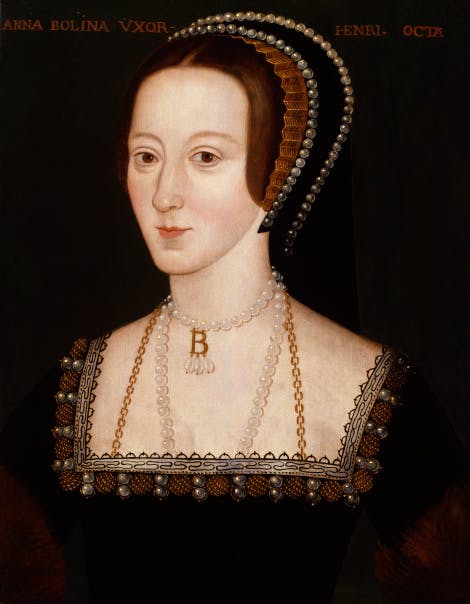
Anne Boleyn
How did Anne Boleyn become queen and why did Henry VIII execute her?

Arbella Stuart
From contender for the throne to prisoner in the Tower of London
Explore what's on

- Things to see
Battlements
Walk the defensive walls and huge towers that have guarded the Tower of London for centuries.
- Open
- Tower of London
- Included in palace admission (Members go free)

- For members
- Events
Members-only Ceremony of the Keys
Members-only access to the traditional locking up of the Tower of London, the Ceremony of the Keys.
-
18 January, 08 February, 22 March 2026
- 21:30
- Tower of London
- Separate ticket (advance booking required)

- Tours and talks
Ceremony of the Keys
Be part of this ancient tradition, which has taken place every night for at least 700 years in the Ceremony of the Keys at the Tower of London.
-
Daily (next ticket release 05 January 2026)
- From 21:30-22:05
- Tower of London
- Separate ticket (advance booking required)
Shop online

Tower of London Navy Raven Sweatshirt
Inspired by the infamous ravens of the Tower of London, this sweatshirt will keep you warm on those chilly days.
£38.00

Shop Six Wives of Henry VIII
'Divorced, Beheaded, Died: Divorced, Beheaded, Survived' - this best selling range is as colourful as it is informative.
From £15

Shop Ravens
It is said that if the six ravens were ever to leave the Tower of London then the Tower and the kingdom will fall. Naturally, to preserve the kingdom six ravens are kept to live and protect the Tower of London.
From £2.50
